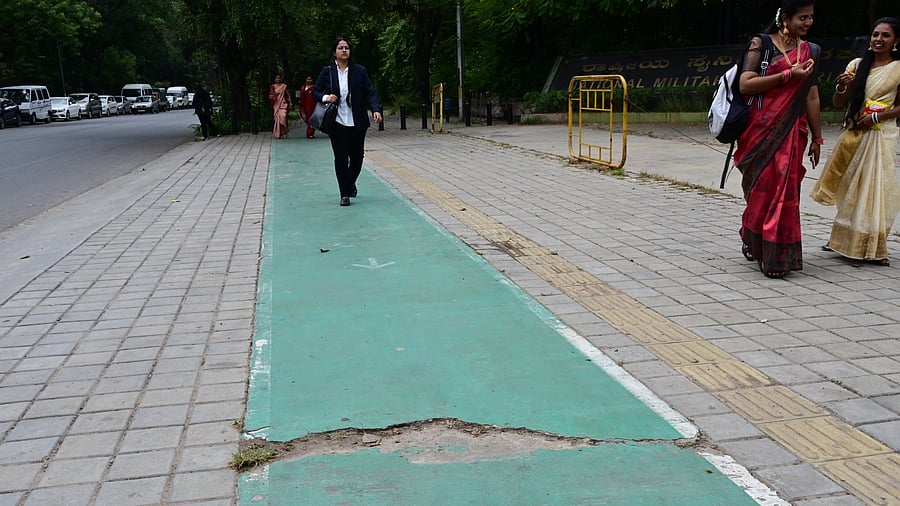
The cycling track near Raj Bhavan is used by pedestrians.
Credit: DH PHOTO
Bengaluru: Though the city’s cycling community is growing, cycling infrastructure remains abysmal, cyclists tell Metrolife.
Greater Bengaluru Authority’s (GBA) proposed ‘Clean Air Zone’ road map, which aims to cut particulate matter emission by up to 90% and nitrogen oxide emissions by 70% by 2035, hopes to achieve the goal by promoting walking and cycling. “But how can one do that without proper cycling and walking infrastructure?” asks Sathya Sankaran, bicycle mayor of Bengaluru.
When Metrolife took a walk down Raj Bhavan Road, which has one of the city’s cycling tracks, we learnt that it was in decent condition. However, as it has been created on the footpath, it is often used by pedestrians. “There is no awareness that it is a cycling track,” points out Abhishek Choudhary, a cycling enthusiast.
The TenderSURE roads in the central business district, a 2 km-stretch in Yelahanka, and a 1 km-stretch on HAL Airport Road, are some other tracks in the city, says Sankaran. Through his website Altmo, which tracks how users commute to work, he has been submitting inputs to the Directorate of Urban Land Transport (DULT) on making roads cyclist-friendly. His team has also submitted recommendations to the state government on how infrastructure can be improved to make it conducive for walking and cycling.
Choudhary, who works at a pharmaceutical company in Whitefield, notes, “Hyderabad has a 25 km cycling loop. Authorities should consider creating something like that in Bengaluru.” He cycles an average of 110 km every weekend.
Potholes and dust
Raghav Kini, chief revenue officer at a consulting and communications company, often rides on the weekends during non-peak hours. “But even then, it is unsafe,” says Kini. He typically starts from his home in Sadashivanagar and heads towards the airport. But when short on time, he rides within the city. “Potholes, waterlogging, traffic, uneven patches — we face all the same problems as other motorists. But cycling is all about getting into a rhythm, and when the rhythm is broken, it is tiring to get back into it,” he explains.
Sankaran flags dust as another major obstacle. “My cycle slid off balance twice last week, because of the dust piled by the side of the road,” he says, adding that unchecked construction has led to a significant increase in dust.
Construction debris
Shilpi Sahu has been commuting to work by bicycle for 15 years. She lives in the Bellandur area and covers a distance of 11 km to reach her office in Mahadevapura. “It takes about 45 minutes one way. Driving is out of the question as it takes much longer, and so does taking the bus,” says the 46-year-old. Shilpi routinely grapples with potholes, mud and rash drivers. “I was hit by a two-wheeler two years ago and sustained bruises on my shoulder and knees. Quite often, I fall off the bike while trying to avoid construction debris,” she shares. Over 100 of her coworkers cycle to work.
A 17 km track, called the ‘pop-up cycling track’ which came up on the Outer Ring Road during the pandemic, has been removed for metro construction. “We hope the GBA reintroduces it. It is important to have a network of cycling tracks, rather than short disconnected stretches,” Sankaran explains.
Officials from DULT and GBA were unavailable for comment.